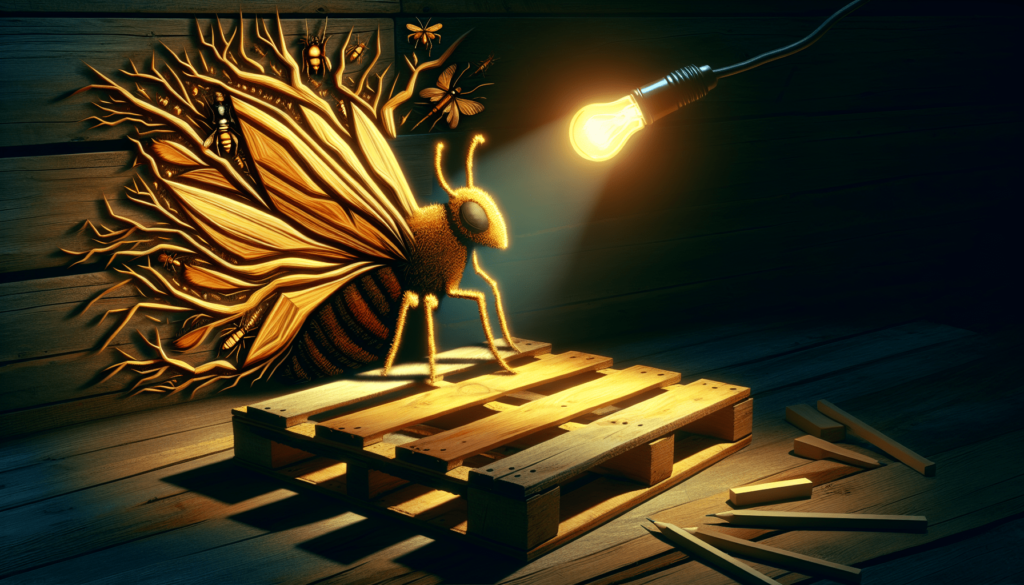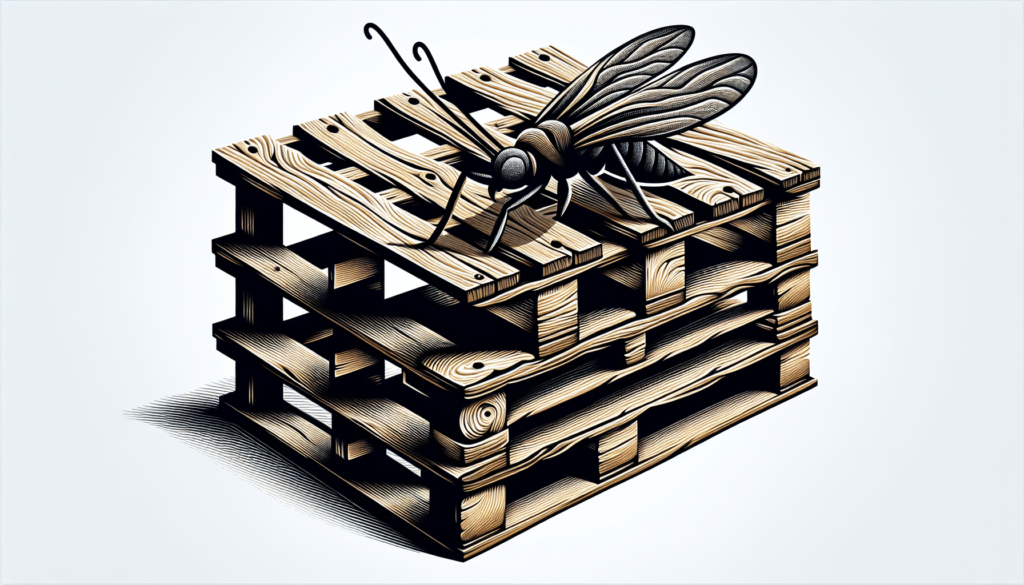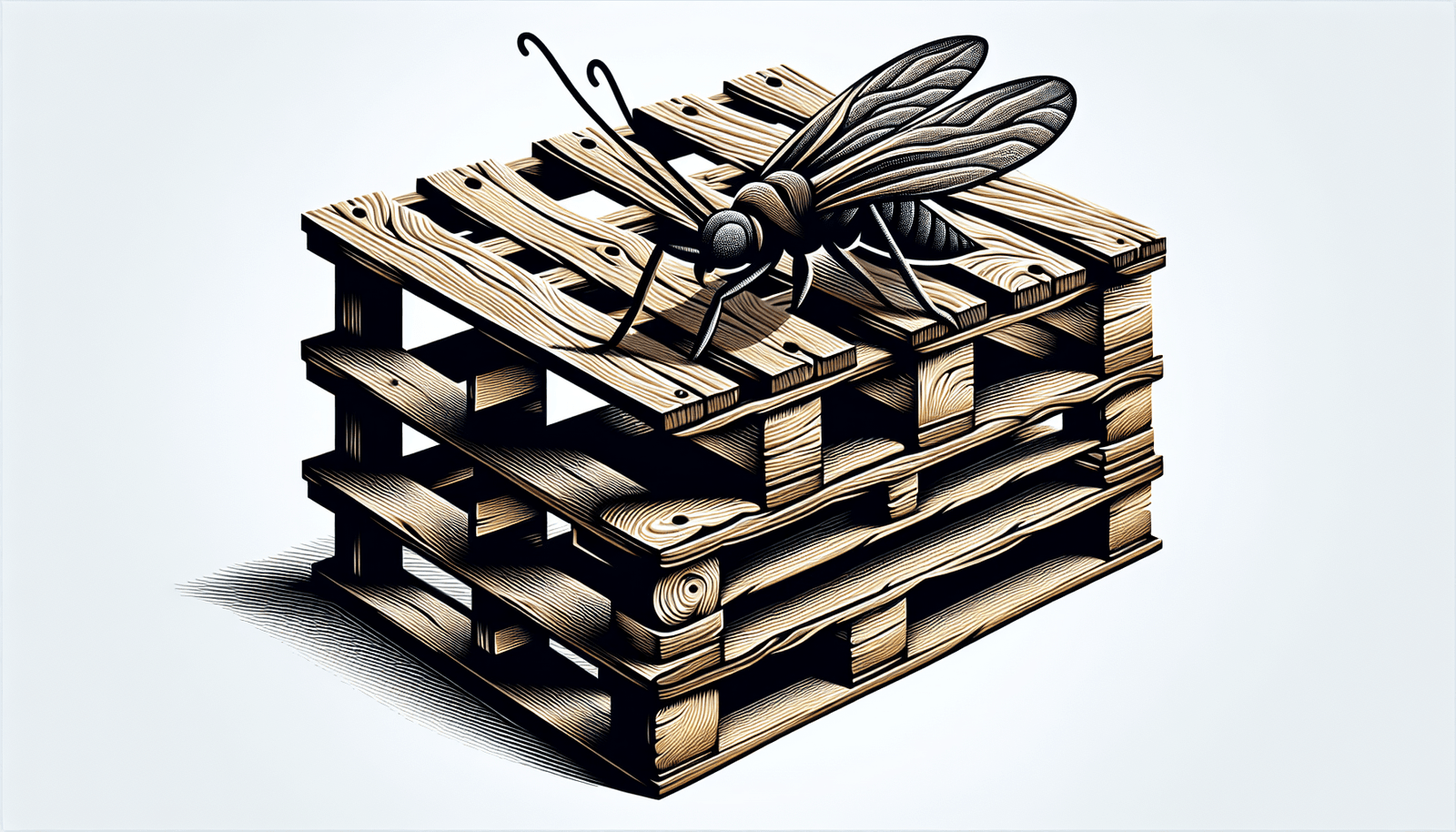If you’ve ever wondered whether wooden pallets have a magnetic draw for pesky bugs, then this article is for you. Discover the truth behind the buzz and gain clarity on whether or not these commonly used shipping platforms are bug magnets. From exploring the nature of wooden pallets to understanding the factors that make them appealing (or unappealing) to insects, you’ll find all the answers you need to put your bug-related concerns to rest. Yes, they do! Wooden pallets are indeed a common attraction for various types of bugs. If you often work with wooden pallets or have them stored in your home or warehouse, it is essential to be aware of the potential bug infestations that can occur. In this article, we will explore the different types of bugs attracted to wooden pallets, factors that influence this attraction, the effects of bug infestations, and most importantly, how to prevent and handle such infestations.
Common Types of Bugs Attracted to Wooden Pallets
Termites
Termites are notorious for their affinity for wood, and wooden pallets are no exception. These tiny insects feed on cellulose found in wood, and they can cause significant damage if left unchecked. Termite infestations in wooden pallets can compromise their structural integrity and pose a risk to surrounding areas.
Powderpost Beetles
Powderpost beetles are another common pest attracted to wooden pallets. These insects lay their eggs on the surface of the wood, and once the larvae hatch, they bore into the wood, leaving behind small exit holes and a powdery substance known as frass. The damage caused by powderpost beetles can weaken the pallets and make them less durable.
Carpenter Ants
Carpenter ants are attracted to damp and decaying wood, making wooden pallets an ideal environment for their nesting activities. While they do not feed on wood, they excavate tunnels and galleries within the pallets, causing significant structural damage over time.
Wood Boring Beetles
Wood boring beetles, such as the common furniture beetle, are known to infest wooden pallets. These beetles lay their eggs on the wood surface, and the larvae tunnel into the wood as they feed. This continuous tunneling weakens the pallet and can result in breakage.
Cockroaches
Cockroaches are resilient pests that can infest various environments, including wooden pallets. These nocturnal insects are attracted to food sources, warmth, and moisture, all of which can be present in wooden pallets used for storage or transport.
Woodlice
Woodlice, also known as sowbugs or pillbugs, are small crustaceans that are often found in dark and damp areas. They are attracted to decomposing organic matter, including moist wooden pallets. While woodlice do not directly cause damage to the pallets, their presence may indicate underlying moisture issues.
Booklice
Booklice, despite their name, are not lice but rather tiny insects that infest books and other organic material, including wooden pallets. They are attracted to the moisture and mold that can develop in damp wood.
Fungus Gnats
Fungus gnats are small flying insects that are attracted to damp environments, such as the moist wood found in wooden pallets. These gnats can lay their eggs in the damp soil in the pallets, leading to an infestation that can be challenging to eradicate.
Mites
Mites are microscopic arachnids that can infest wooden pallets. These pests feed on fungi, mold, and organic matter found in moist wood. While they may not directly damage the pallets, their presence can contribute to the overall deterioration of the wood.
Earwigs
Earwigs are nocturnal insects known for their pincer-like appendages. They are attracted to dark and damp areas, and wooden pallets can provide a suitable habitat for them. While earwigs do not directly damage the wood, their presence may be an indication of moisture issues.
Factors Influencing Bug Attraction to Wooden Pallets
Moisture Content of Pallet Wood
The moisture content of wooden pallets is a crucial factor in attracting bugs. Pallets with high moisture content are more likely to harbor mold, fungi, and decaying organic matter, which in turn attracts various types of bugs.
Type and Treatment of Wood
Different wood species and the treatment they undergo can influence bug attraction. Some wood species are naturally more resistant to bugs, while others are more susceptible. Additionally, the treatment processes used, such as pressure treatment or heat treatment, can deter or reduce bug infestations.
Outdoor or Indoor Storage
The storage environment plays a significant role in bug attraction. Outdoor storage exposes pallets to a wider range of environmental factors and increases the likelihood of bug infestation compared to indoor storage.
Proximity to Vegetation
Wooden pallets placed in close proximity to vegetation, such as trees or plants, may attract bugs. Insects like termites, ants, and beetles may find their way from the vegetation to the pallets, seeking food and shelter.
Proximity to Food Sources
If pallets are used to store food items or placed near areas with food sources, they are more likely to attract bugs like cockroaches and gnats. The presence of organic matter, spills, or crumbs can provide a food source for these pests.
Temperature and Humidity
Bugs are attracted to specific temperature and humidity conditions. Higher temperatures and increased humidity levels can create an environment that is optimal for bug infestations in wooden pallets.
Lack of Cleaning and Maintenance
Neglecting regular cleaning and maintenance of wooden pallets can contribute to bug infestations. Accumulated dirt, spills, and debris can attract insects and create an ideal habitat for them to thrive.
Existing Infestation
If you already have bug-infested pallets in your storage area, it is more likely that adjacent pallets will become infested as well. Bugs can easily spread from one pallet to another, increasing the risk of widespread infestation.
Pallet Age and Condition
Older pallets that have been exposed to prolonged use and environmental factors may be more susceptible to bug infestations. As the wood deteriorates over time, it becomes more attractive to bugs seeking weakened or decaying material.
Geographical Location
The geographical location of your storage area can also influence bug attraction to wooden pallets. Certain regions have a higher prevalence of specific pests, and understanding the local bug populations can help you take appropriate preventive measures.

Effects of Bug Infestations in Wooden Pallets
Structural Damage
Bug infestations can cause significant structural damage to wooden pallets. Termites, carpenter ants, and wood-boring beetles can weaken the wood by tunneling and excavating galleries, compromising the integrity of the pallets.
Spread of Infestation to Surrounding Areas
When bug-infested pallets are stacked or stored together, the insects can easily spread from one pallet to another. This can result in a widespread infestation that not only affects the pallets but also nearby furniture, structures, or stored items.
Contamination of Stored Goods
Bug infestations in wooden pallets can lead to contamination of stored goods. Insects, their waste, and eggs can contaminate food products, packaging, or other items, posing health risks and creating an unsanitary environment.
Health and Hygiene Concerns
Bug infestations can also pose health and hygiene concerns. Cockroaches, gnats, and other insects that infest pallets can carry bacteria, pathogens, or allergens that can be harmful to humans. Insects like mosquitoes or ticks may also transmit diseases.
Insect Bites and Allergies
When working with bug-infested wooden pallets, there is an increased risk of insect bites and allergic reactions. Bites from certain pests can be painful, itchy, or cause allergic reactions, potentially leading to discomfort and health complications.
Preventing Bug Infestations in Wooden Pallets
Using Treated or Insect-Resistant Pallets
One effective way to prevent bug infestations in wooden pallets is to use treated or insect-resistant pallets. Pressure-treated pallets or those treated with insecticides can deter or repel bugs, reducing the risk of infestation.
Proper Storage and Handling
Implementing proper storage and handling practices is essential for preventing bug infestations. Pallets should be stored in a clean and dry area, away from vegetation, food sources, or sources of moisture. Regular inspection and rotation can also help detect and address potential bug issues early on.
Regular Inspection and Maintenance
Frequent inspection and maintenance of wooden pallets are necessary to identify and address any bug infestations promptly. This includes checking for signs of damage, holes, frass, or insect activity. Any infested pallets should be isolated and dealt with immediately.
Controlling Moisture and Humidity
Controlling moisture and humidity levels is crucial for bug prevention. Proper ventilation, moisture barriers, and dehumidifiers can help reduce the attractiveness of wooden pallets to bugs by creating a dry and inhospitable environment.
Keeping Surrounding Areas Clean
Maintaining cleanliness in the surrounding areas is important to minimize bug attraction. Regular cleaning and removal of spills, debris, and organic matter can deter insects from getting attracted to wooden pallets.
Using Pest Deterrents
Various pest deterrents are available that can be used in conjunction with wooden pallets to prevent bug infestations. These may include essential oils, deterrent sprays, or natural substances that repel bugs.
Quarantine and Isolation Measures
Implementing quarantine and isolation measures can help contain and prevent the spread of bug infestations. Newly arrived or suspected bug-infested pallets should be isolated from the rest until they can be inspected and properly treated.
Prompt Removal and Destruction of Infested Pallets
When bug infestations are identified and confirmed, it is crucial to promptly remove and destroy the infested pallets. Proper disposal methods should be followed to prevent the bugs from spreading to other areas or pallets.
Professional Pest Control Services
In severe infestation cases or for ongoing bug prevention, seeking professional pest control services is highly recommended. Pest control experts can provide tailored solutions, conduct thorough inspections, and implement effective treatments to eliminate bugs and prevent future infestations.
Educating Employees and Stakeholders
Educating employees and stakeholders about bug prevention and detection is essential in maintaining a bug-free environment. Training programs or informational materials can help raise awareness about the risks of bug infestations in wooden pallets and encourage proactive measures.

Best Practices for Handling Infested Wooden Pallets
Identification and Confirmation of Infestation
To effectively handle infested wooden pallets, it is crucial to accurately identify and confirm the presence of bugs. This can be done through visual inspections, checking for signs of damage, exit holes, or insect activity.
Isolating Infested Pallets
When infested pallets are identified, they should be isolated from non-infested pallets to prevent the spread of bugs. Stacking the infested pallets separately or removing them from the storage area altogether can help contain the infestation.
Safe Disposal and Destruction Methods
Infested wooden pallets should be disposed of and destroyed safely to prevent further bug spread. Burning the pallets or utilizing specific disposal methods recommended by local authorities can help eliminate bugs effectively.
Cleaning and Sanitization Procedures
Cleaning and sanitizing the surrounding areas, tools, and equipment after handling infested pallets is essential. This helps prevent the potential spread of bugs, their eggs, or contaminants to other areas or stored goods.
Monitoring and Follow-up Measures
After handling infested pallets, it is important to continue monitoring the area for any signs of re-infestation. Regular inspections and follow-up measures, such as using pest traps or monitoring devices, can help ensure the eradication of bugs and prevent future infestations.
Treatment Options for Bug-Infested Wooden Pallets
Heat Treatment
Heat treatment involves subjecting infested wooden pallets to high temperatures for a specific duration of time. This process kills bugs, larvae, and eggs by denaturing their proteins. Heat treatment is effective against a wide range of pests, including termites, beetles, and ants.
Chemical Treatment
Chemical treatments involve the application of insecticides or pesticides to the infested wooden pallets. This approach targets bugs directly, killing them and often providing residual protection against future infestations.
Fumigation
Fumigation is a more intensive treatment option typically conducted by professionals. It involves enclosing the infested pallets in a sealed space and introducing fumigants that penetrate the wood, killing bugs and eggs. Fumigation is highly effective in eliminating various pests, including termites and beetles.
Freezing
Freezing infested wooden pallets at sub-zero temperatures can effectively kill bugs, larvae, and eggs. This treatment option requires specialized freezing equipment and controlled conditions to ensure complete eradication.
Solarization
Solarization is a natural treatment method that utilizes the sun’s heat to kill bugs and their eggs. It involves placing the infested pallets in direct sunlight, raising the temperature inside the wood and effectively eliminating the pests.
Alternatives to Wooden Pallets
Plastic Pallets
Plastic pallets are a popular alternative to wooden pallets. They are resistant to bug infestations, more durable, and easier to clean and maintain. Plastic pallets are also less susceptible to environmental factors such as moisture, humidity, and temperature variations.
Metal Pallets
Metal pallets offer excellent durability and strength, making them suitable for heavy-duty applications. They are also bug-resistant and fire-resistant, providing an added advantage over wooden pallets. However, metal pallets can be costly and heavier compared to other alternatives.
Cardboard Pallets
Cardboard pallets are lightweight, easy to handle, and cost-effective. While they may not be as durable as wooden or plastic pallets, they can be a suitable option for one-time or single-use scenarios. However, cardboard pallets are not suitable for wet or humid environments.
Composite Pallets
Composite pallets are made from a combination of wood fibers and plastic resins, offering the benefits of both materials. They are bug-resistant, water-resistant, and typically more durable than wooden pallets. Composite pallets also provide a sustainable alternative by utilizing recycled materials.
Pallet Rental and Pooling Systems
An alternative to purchasing and maintaining pallets is to participate in pallet rental or pooling systems. These systems allow businesses to rent or lease pallets for specific periods, reducing the need for long-term pallet storage and maintenance. Rental or pooling systems often ensure the use of well-maintained, bug-free pallets.
Conclusion
Wooden pallets can indeed attract various types of bugs, posing risks to the integrity of the pallets, the hygiene of stored goods, and the overall health and safety of individuals. However, with proper preventive measures, regular inspections, and prompt actions, bug infestations can be minimized or eliminated. Consider the type and treatment of wood, control moisture levels, maintain cleanliness, and seek professional assistance when necessary. Exploring alternative materials or participating in rental or pooling systems can also be a viable option. By understanding the common types of bugs attracted to wooden pallets and implementing preventive strategies, you can protect your pallets, stored goods, and the well-being of those around you.

Hi, I’m James Gheen, the creator behindWoodRebirth.com. As someone passionate about sustainability and environmental stewardship, I created this pioneering online platform to change how we approach wood waste and pallet disposal. Through detailed recycling and disposal guides, creative DIY projects, and upcycling inspirations, I aim to inspire individuals and businesses to adopt eco-friendly practices in their wood waste management. At WoodRebirth.com, we foster a vibrant community focused on education and engagement, encouraging the sharing of ideas and success stories. Join me in our mission to give wood waste a new lease on life, making a tangible impact on our environment, one pallet at a time.

